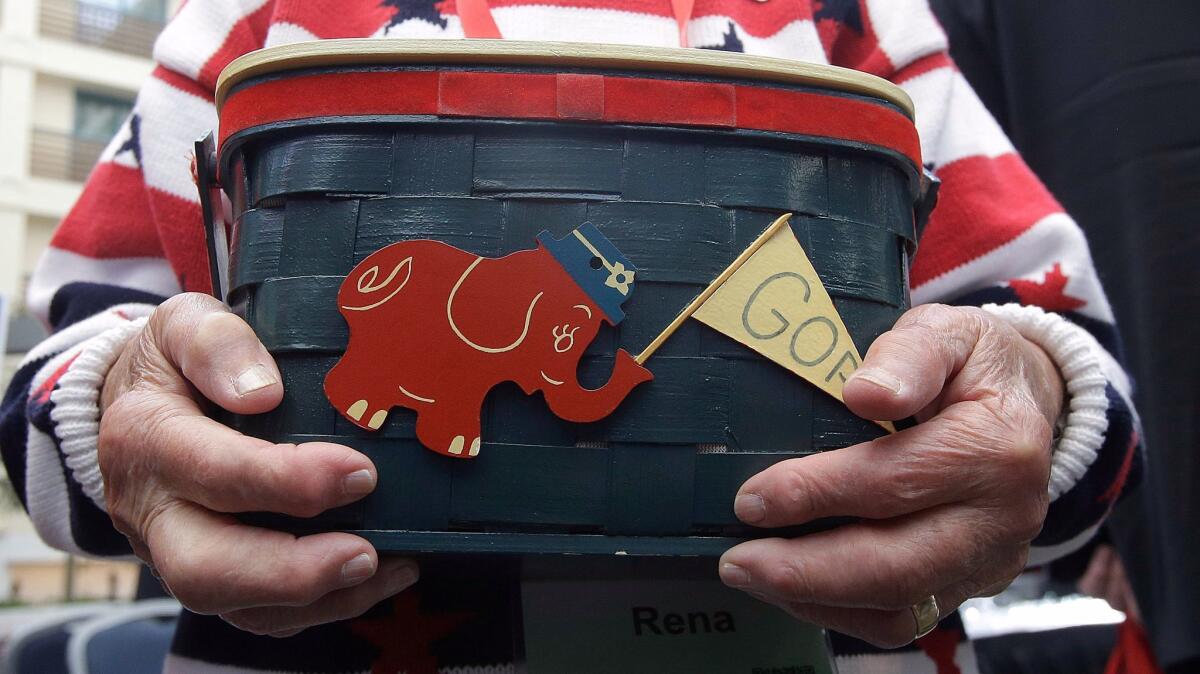Column: The major parties just aren’t cutting it for California voters

Reporting from Sacramento — Hardly anyone would be surprised to learn the vast majority of Californians — two in every three adults in the latest statewide poll — thinks the country is headed in the wrong direction. And they’re placing much of the blame on the nation’s two dominant parties.
The political map of red and blue, it seems, isn’t cutting it anymore.
A statewide survey by the nonpartisan Public Policy Institute of California found 64% of likely voters agreed with the statement that the Democratic and Republican parties are doing “such a poor job that a third major party is needed.”
Lest you think this level of disgust is more deeply ingrained in one subset of California voters, consider this: Even though Democrats in the state are the ones railing against the agenda of President Trump and Republicans in Washington, they slightly trail their GOP neighbors in being fed up with the two-party system.
Sixty-two percent of Republicans in the poll said it’s time for a third party to rival the powers that be, compared with 59% of Democrats. Not surprisingly, the sentiment is even stronger among “independent” California voters who don’t register with a party — 72% said the two big political parties aren’t making the grade.
In all other subsets of voters — by age, ethnicity, high school or college graduates and more — just 36% or fewer think the two-party system is working. The message seems loud and clear.
This new, low level of trust in a political world run by Democrats and Republicans comes at the same time that so-called “minor parties” have withered on the vine in California. Only four still have official recognition in the state: the Green Party, the Libertarian Party, the Peace and Freedom Party and the American Independent Party.
Are you an independent voter in California? Not if you checked this box »
The most recent statewide voter registration report shows three of those parties, when combined, are only a little larger than the number of voters in some single Assembly districts. In the case of the state’s largest third party, the American Independent Party, a Times investigation last year made it clear some voters pick it thinking they’re actually choosing no party at all.
In general, the trend for third party registration has been downward. Even as 10 other groups have asked California officials to be officially recognized as a political party, the hurdles under state election law — based on how many voters are willing to enlist — are high, both for getting that status and for keeping it.
Then there’s the other part of the story about the barrier for third parties in California, one the new poll suggests voters don’t know anything about. The PPIC survey found strong support for the state’s top-two primary, the 7-year-old system in which only two candidates win a spot on the general election ballot. The old system gave each qualified party a spot on that ballot. In November 2002, the Green Party’s Peter Camejo won 5% of the statewide vote in the race for governor — a high-water mark in third-party politics.
Under the top-two primary, though, minor parties are pretty much guaranteed a spot on the sidelines on the election day that settles the race. The new poll, it seems, reflects the ultimate in electoral stalemates: Voters don’t like their choices, but also don’t like the system that used to offer lots of them. Assuming that Californians don’t want to revisit the rules regarding primaries, they’ll have to find a way to change the major political parties themselves — a tough task when confidence is already so low.
Follow @johnmyers on Twitter, sign up for our daily Essential Politics newsletter and listen to the weekly California Politics Podcast
ALSO:
Political Road Map: The state’s political parties would like to kill the top-two primary
Updates on California politics
More to Read
Get the L.A. Times Politics newsletter
Deeply reported insights into legislation, politics and policy from Sacramento, Washington and beyond. In your inbox three times per week.
You may occasionally receive promotional content from the Los Angeles Times.











